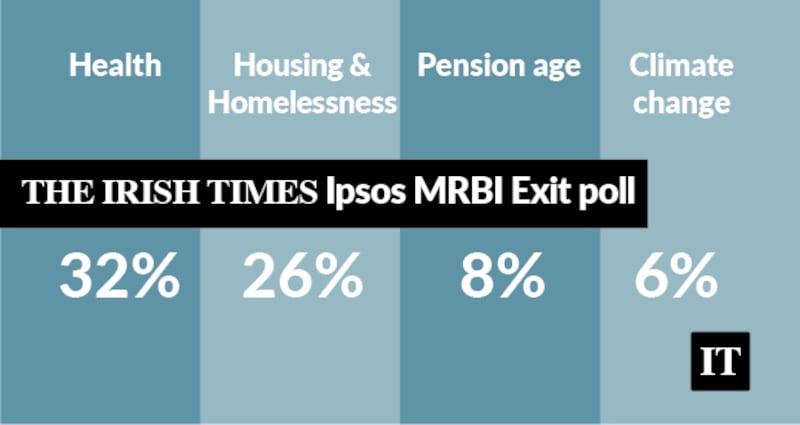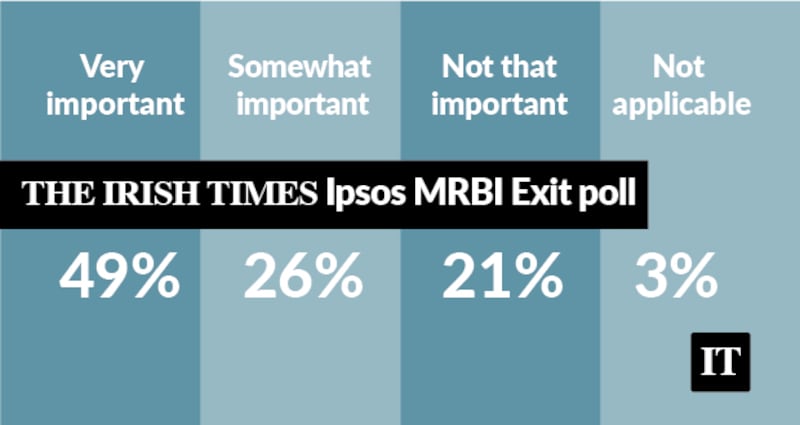The dead heat between the three biggest parties in the general election reflects a remarkable generational divide between those who voted for the two Civil War parties and those who voted for Sinn Féin.
It is clear from the exit poll that the surge of support for Sinn Féin among younger voters turned the election into a three-way contest – the first time this has happened in the history of the state.
A breakdown of the figures in the exit poll shows that Sinn Féin won almost 32 per cent of the votes of young people aged between 18 and 24 and a similar proportion of those between 25 and 34. This declined to just 12.2 per cent of those in the over 65 age category.
0 of 4
By contrast Fine Gael won only 15.5 per cent of the votes among the age 18-24 age group and 30.2 per cent of those aged 65 and over. The pattern of support among Fianna Fáil voters was similar with the party winning 13.6 per cent among the 18- to 24-year-olds and 29.7 per cent among the over 65s.
Which one of these was most important to you in deciding how to vote today?

The yawning divide between the voting behaviour of young people and their elders is probably down to two issues.
One is the housing crisis which clearly affects young voters far more than their elders. The other is the memory of the IRA campaign of violence which was a defining experience for many older voters.
The Green Party also did well among younger voters winning the support of 14.4 per cent of 18- to 24-year-olds and just 4.6 per cent of the over 65s. By contrast the Labour Party won a paltry 2.6 per cent support among the youngest voters and 5.1 per cent among the over 65s.
Labour
Less than a decade ago in the run up to the 2011 general election Labour was polling over 30 per cent support among the youngest age groups and it won 19.4 per cent of the vote, its highest ever, in that election.
There was no substantial gender divide in terms of party support with Sinn Féin marginally more attractive to men and the Green Party a little more attractive to women.
There was some regional variation in the poll and it was most pronounced in relation to Fianna Fáil, the Greens and Labour. What may be a worry for Fianna Fáil when the counts get under way on Sunday is that its support in Dublin at 14 per cent is well behind Fine Gael which is on 21 per cent and Sinn Féin on 22 per cent.
That could make it difficult for the party to gain the number of seats it had expected in the capital. The party is doing much better outside the capital where it is winning between 22 per cent and 26 per cent.
How important was the ability to manage the economy to how you voted today?

There is not a lot of variation in the Fine Gael or Sinn Féin vote across the country. By contrast the Greens and Labour are doing significantly better in the capital than they are outside it.
As for the smaller parties the Social Democrats are registering 3.4 per cent which is not far behind Labour while Solidarity is on 2.8 per cent and Aontú on 1.8 per cent. For all of the smaller parties the number of seats won will depend on how their vote is concentrated in specific constituencies.
The share of the vote won by Independents and Others at 12.7 per cent is well down on the 20 per cent share they won at the last election. Sinn Féin has clearly picked up a lot of support that previously went to this group.
Even allowing for the 1.5 per cent margin of error in the poll it is clear that the three biggest parties will be bunched closely together when the votes are counted. This makes it extremely difficult to extrapolate the number of seats each party is likely to get in the end.
Sinn Féin will regret that it had just 42 candidates compared with 82 for Fine Gael and 84 for Fianna Fáil.
There will inevitably be a number of constituencies where Sinn Féin has surplus votes with nobody from the party to pick them up.
One of the big questions is where those surplus Sinn Féin votes will go during the counts. It is likely that a significant share will go to the Greens and the smaller left-wing parties and could help them to win extra seats.
How important was the party leader to how you voted today?

Fine Gael and Fianna Fáil between them look like winning around 45 per cent of the vote, a drop of five points since the last election and the lowest combined share ever obtained by the two big parties.
Transfers will be decisive in deciding how the final seats go in all 39 constituencies. The exit poll showed Fianna Fáil only marginally more transfer friendly than Fine Gael. Fianna Fáil does best in transfers from Independents while Fine Gael does better from Labour and Green transfers.
The Greens get strong transfers from the smaller left-wing parties and Independents while Sinn Féin transfers favour Independents and the small left-wing parties.
Things to look out for during the count
1. Watch Sinn Féin topping the poll in a number of constituencies but be aware that in 36 or them the party is running just one candidate. It means there are only three constituencies where it can win more than one seat no matter how many votes its gets. One of the deciding factors in the election will be where the Sinn Féin surplus votes go. The poll suggest that Independents and the small left-wing parties will benefit most.
2. Will Fine Gael or Fianna Fáil prove more transfer friendly? In 2011, Fianna Fáil was transfer repellent and won less seats than it should have because of that. It did better last time as the hostility to it faded so it should do reasonably well this time. As the party of Government Fine Gael may struggle to get transfers but its old Labour allies may come to the rescue in vital constituencies.
3. How well will the Greens be able to do on around 8 per cent of the national vote? The poll shows it is on more than 14 per cent in Dublin which gives it a chance in all 11 constituencies in the capital. It can win some more around the country if its vote is concentrated as the Greens always do well on transfers.
4. How bad will it be for Labour? In the past the oldest party in the State has managed to eke out seats on a relatively small share of the national vote but it is really up against it this time.
5. Will some of the high-profile Independents who did so well in the last election find the going too tough this time around? The performance of Minister for Sport Shane Ross in Dublin Rathdown will be one to watch as will his former Independence Alliance colleagues Kevin "Boxer" Moran in Longford-Westmeath and Seán Canney in East Galway.
Stephen Collins is a former Irish Times political editor














